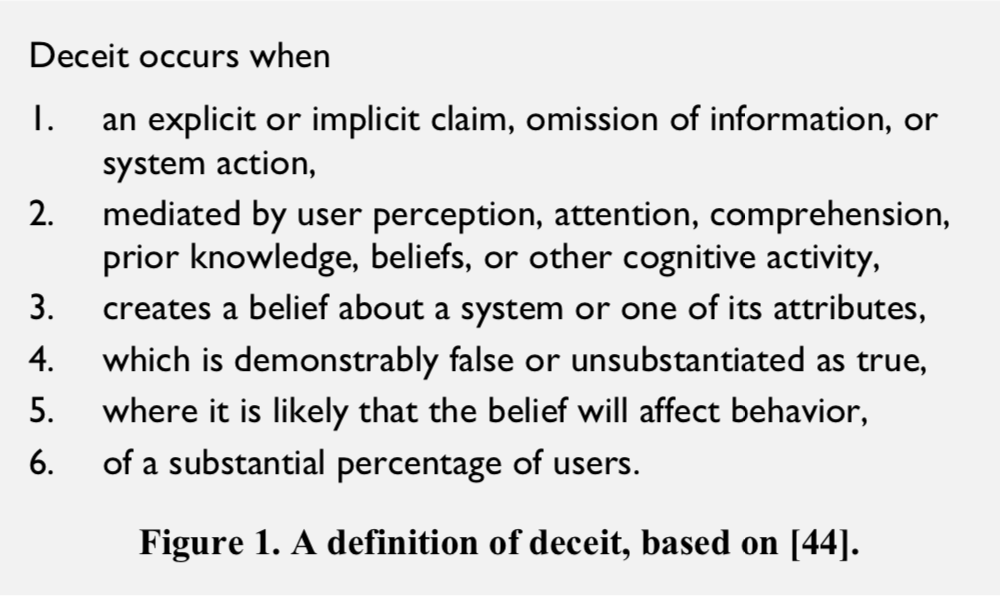either by hiding truthful information or showing false in- formation. Deception is an act of deceit with
implied intent (e.g., telling the user the web page is 70% loaded when we know that this is not the case).
On the other hand, decep- tive(ness) does not require intent (e.g., telling the user that the web page is
absolutely 70% loaded based on some esti- mate with high error margins). Though this distinction is
important as it speaks to motive, deceit exists with or with- out intent. In fact, when deciding whether an
advertisement is illegal (false), the FCC only considers the deceptiveness of the message irrespective of
intent. That said, proving motive/intent in a design is also a very convincing argu- ment for conviction.
There is a notable difference between unintentional bugs, errors, or bad metaphors and ones that have
been carefully designed for specific purposes.
Benevolent deception is ubiquitous in real-world system designs, although it is rarely described in such terms. One example of benevolent deception can be seen in a robotic physical therapy system to help people regain movement following a stroke [8]. Here, the robot therapist provides stroke patients with visual feedback on the amount of force they exert. Patients often have selfimposed limits, believ- ing, for example, that they can only exert a certain amount of force. The system helps patients overcome their percep- tive limits by underreporting the amount of force the patient actually exerts and encouraging additional force.

It is further useful to distinguish between deceit that affects behavior directly or indirectly (by modifying
the user’s mental model). A test of this impact is whether a user would behave differently if they knew the
truth. Though theline is fuzzy, this distinction allows us to separate abstrac- tion from deception. Applying
this thought experiment to deception interfaces, one might see that the 1ESS user who was connected to
the wrong number might begin to blame and mistrust the system, the rehabilitation user may recali- brate
what is on the screen and again be unwilling to push themselves, and so on. Though the line is fuzzy, this
dis- tinction allows us to separate abstraction (or simplification), in which user behavior is largely
unchanged, from decep- tion, in which it often is changed.
Building on behavioral and legal definitions introduced in earlier work [44] that deal with deceptive
advertising, we put forth a working definition of deceit as it applies to HCI work in the Figure 1. Points 5 &
6, on substantial effect, are perhaps the most controversial, and are purposefully left ambiguous. How
behavior is affected and what “substan- tial” means are left open, as there is likely no answer that works in
every situation. A deceptive interface that causes physical harm in 1% of the user population may have a
sub- stantial effect, whereas an idempotent interface with a but- ton that misleads significantly more users
into clicking twice may not pass the substantial test.
In addition to intent, there are many other ontologies of deceit. Bell and Whaley [4] identify two main
types of de- ception—hiding and showing—which roughly correspond to masking characteristics of the
truth or generating false information (both in the service of occluding the truth). These forms of deception
represent atomic, abstract notions of deceit that we refine in our discussion below. Related to the hiding/
showing dichotomy is the split between silent (a deceptive omission) versus expressed deception. Lying,
as a special class, is generally considered to be a verbal form of deception [5]. Because HCI need not
involve a verbal ele- ment, we expand the notion of the “lie” to include non- verbal communication
between humans and computers.